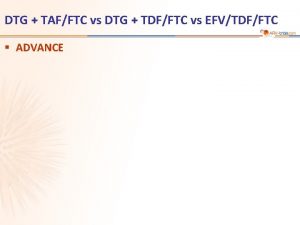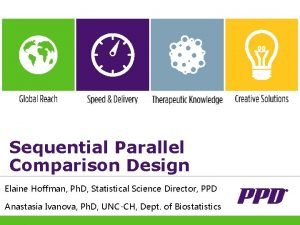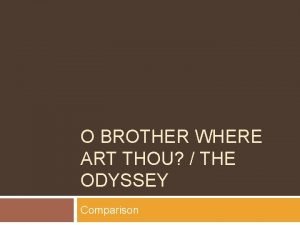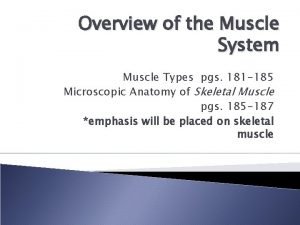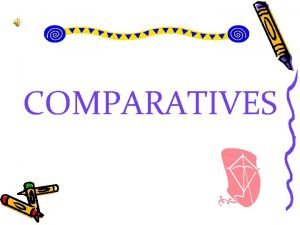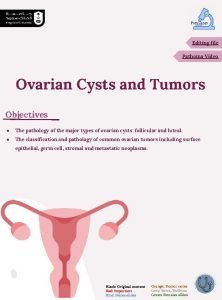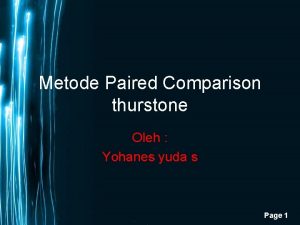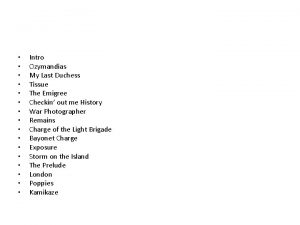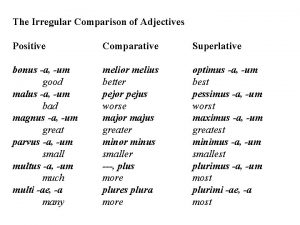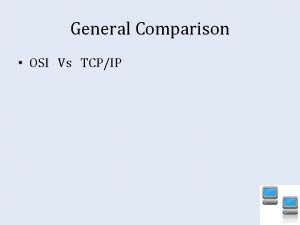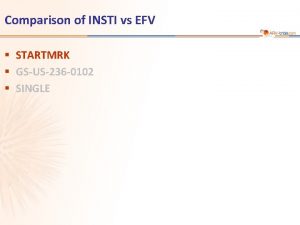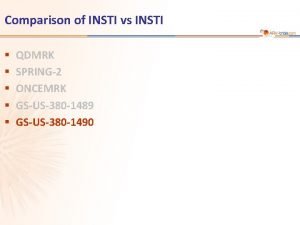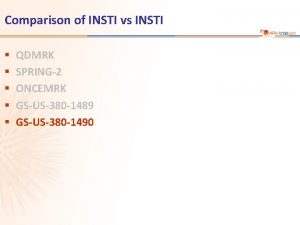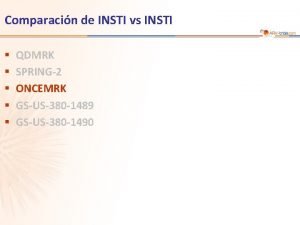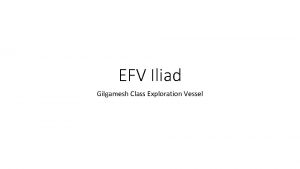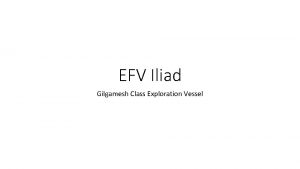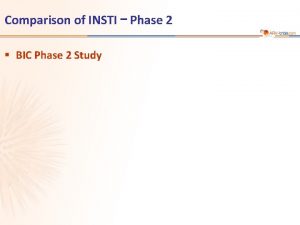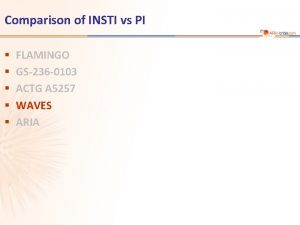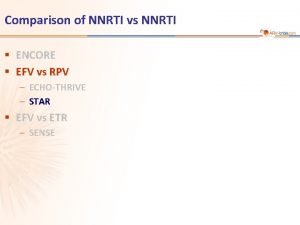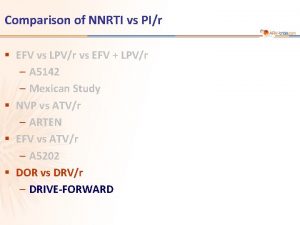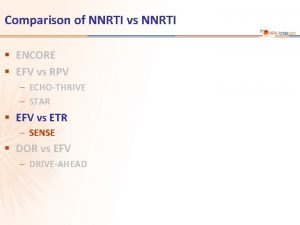Comparison of INSTI vs EFV STARTMRK GSUS236 0102












- Slides: 12

Comparison of INSTI vs EFV § STARTMRK § GS-US-236 -0102 § SINGLE

SINGLE Study: DTG + ABC/3 TC vs TDF/FTC/EFV QD § Design Randomisation* 1: 1 Double-blind > 18 years ARV-naïve HIV RNA > 1, 000 c/m. L Any CD 4 cell count HBs. Ag negative No genotypic resistance HLA-B*5701 negative N = 422 W 96 DTG 50 mg + ABC/3 TC FDC QD TDF/FTC/EFV placebo N = 422 W 144 Open-label TDF/FTC/EFV QD DTG placebo + ABC/3 TC placebo *Randomisation was stratified by HIV RNA (< or > 100, 000 c/m. L) and CD 4/mm 3 (< or > 200) at screening § Objective – Non inferiority of DTG at W 48: % HIV RNA < 50 c/m. L by intention to treat, snapshot analysis (1 -sided significance level of 2. 5%, lower margin of the 95% CI for the difference = -10%, 90% power) SINGLE Walmsley S. NEJM 2013; 369: 1807 -18

SINGLE Study: DTG + ABC/3 TC vs TDF/FTC/EFV QD Baseline characteristics and patient disposition DTG + ABC/3 TC N = 414 TDF/FTC/EFV N = 419 36 35 Female 16% 15% HIV RNA (log 10 c/m. L), median 4. 67 4. 70 HIV RNA > 100, 000 c/m. L 32% 31% CD 4 cell count (/mm 3), median 335 339 CD 4 < 200 per mm 3 14% 15% Hepatitis C coinfection 7% 7% Discontinuation by W 48 51 (12. 3%) 84 (20. 0%) For lack of efficacy N = 14 N = 13 For adverse event N = 10 N = 42 Lost to follow-up N = 14 N=9 N=7/N=5 N = 7 / N = 11 Median age, years Protocol deviation / Withdrew consent SINGLE Walmsley S. NEJM 2013; 369: 1807 -18

SINGLE Study: DTG + ABC/3 TC vs TDF/FTC/EFV QD Response to treatment at week 48 HIV RNA < 50 c/m. L % 100 DTG + ABC/3 TC TDF/FTC/EFV Primary analysis 87. 9 89. 8 80. 7 81. 3 75 50 Differences in viral suppression were also seen in key demographic subgroups including race, sex, age and patients with HIV RNA > 100, 000 c/m. L at baseline 25 0 ITT, snapshot Per protocol Adjusted difference (95% CI) = 7% (2; 12) Adjusted difference (95% CI) = 9% (4; 13) Adjusted mean CD 4/mm 3 increase at W 48 : + 267 for DTG + ABC/3 TC + 208 for TDF/FTC/EFV (p<0. 001) Superiority of DTG + ABC/3 TC SINGLE Walmsley S. NEJM 2013; 369: 1807 -18

SINGLE Study: DTG + ABC/3 TC vs TDF/FTC/EFV QD Response to treatment at week 96 HIV-1 RNA < 50 c/ml (ITT, snapshot) DTG + ABC/3 TC TDF/FTC/EFV % 100 DTG : 80% 80 EFV : 72% 60 Adjusted difference at W 96 (95 % CI) : + 8. 0 % (+ 2. 3 % ; + 13. 8 %) ; P = 0. 006 40 20 0 0 4 8 12 16 24 32 40 48 60 72 84 96 Weeks SINGLE Walmsley S. JAIDS 2015; 70: 515 -9

SINGLE Study: DTG + ABC/3 TC vs TDF/FTC/EFV QD HIV-1 RNA < 50 c/m. L at W 144, ITT snapshot 100 % 88 80 95% CI for Difference Favors EFV/TDF/FTC DTG+ABC/3 TC DTG + ABC/3 TC (N=414) TDF/FTC/EFV (N=419) 81 80 7. 4% 72 71 2. 5% 63 8. 0% 2. 3% 14. 6% 2% 0 -5% 40 W 96 13. 8% 8. 3% 60 W 48 12. 3% W 144 15% 30 20 20 5 0 W 48 W 96 W 144 Virologic success SINGLE 6 W 48 7 8 W 96 10 13 7 W 144 Virologic non-response 7 W 48 18 12 W 96 W 144 No virologic data Walmsley S. JAIDS 2015; 70: 515 -9

SINGLE Study: DTG + ABC/3 TC vs TDF/FTC/EFV QD HIV-1 RNA < 50 c/m. L by baseline stratification factors DTG + ABC/3 TC W 48 outcome Plasma HIV-1 RNA TDF/FTC/EFV Number of Responders/Number Assessed ≤ 100, 000 c/m. L 253/280 (90. 4%) 238/288 (82. 6%) >100, 000 c/m. L 111/134 (82. 8%) 100/131 (76. 3%) > 200/mm 3 319/357 (89. 4%) 290/357 (81. 2%) < 200/mm 3 45/57 (78. 9%) 48/62 (77. 4%) ≤ 100, 000 c/m. L 204/280 (73%) 185/288 (64%) >100, 000 c/m. L 92/134 (69%) 80/131 (61%) > 200/mm 3 262/357 (73%) 230/357 (64%) < 200/mm 3 34/57 (60%) 35/62 (56%) CD 4+ T cell count W 144 outcome Plasma HIV-1 RNA CD 4+ T cell count SINGLE Walmsley S. NEJM 2013; 369: 1807 -18; Walmsley S. JAIDS 2015; 70: 515 -9

SINGLE Study: DTG + ABC/3 TC vs TDF/FTC/EFV QD § Virologic failure definition – 2 consecutive plasma HIV-1 RNA > 50 c/m. L, on or after W 24 § Criteria for resistance testing – All patients with protocol defined virologic failure (PDVF) – Genotype of RT and integrase on baseline and 1 st suspected virologic failure samples Resistance data at PDVF DTG + ABC/3 TC , N = 414 TDF/FTC/EFV, N = 419 D 0 -W 48 -96 W 96 -144 18 (4. 3%) 7 14 17 (4. 1%) 8 8 Integrase genotype at baseline and time of PDVF 7 - - Emergent integrase-R mutations 0* 0 0 0 RT genotype results at baseline and time of PDVF 9 - - Emergent NRTI-R mutations Emergent NNRTI-R mutations 0 0 0 1 (K 65 R) 4** 0 2*** 0 0 PDVF * E 157 Q/P polymorphism in 1 patient with no change in phenotype ** N = 1 with K 101 E, N = 1 with K 103 N, N = 1 with G 190 A, N = 1 with K 103 N + G 190 A ; **** N = 2 with K 103 K/N SINGLE Walmsley S, ICAAC 2012, Abs. H 556 b ; Walmsley S. NEJM 2013; 369: 807 -18 ; Pappa K. ICAAC 2014, Abs. H-647 a ; Walmsley S. JAIDS 2015; 70: 515 -9

SINGLE Study: DTG + ABC/3 TC vs TDF/FTC/EFV QD Adverse events and laboratory abnormalities at week 48 Adverse event leading to discontinuation of study drug Psychiatric disorder, N Nervous system disorder, N Skin and subcutaneous-tissue disorder, N Gastrointestinal disorder, N General disorder or administration-site condition, N Adverse event of grade 2 -4 in > 3% in either group Bronchitis Diarrhoea Nausea Insomnia Anxiety Depression Headache Dizziness Rash Grade 2 -4 elevation of ALT Grade 2 -4 elevation of AST SINGLE DTG + ABC/3 TC TDF/FTC/EFV 10 (2. 4%) 2 0 0 42 (10. 0%) 15 13 8 8 7 2% 5% 2% 4% 2% 2% 3% < 1% 1% 2% 2% 3% 4% 3% 3% 3% 5% 5% Walmsley S. NEJM 2013; 369: 1807 -18

SINGLE Study: DTG + ABC/3 TC vs TDF/FTC/EFV QD § Insomnia was more frequent in DTG group at W 48 (15% vs 10%) § Mean change in creatinine at W 48 on DTG: + 0. 12 to 0. 15 mg/d. L (10. 56 to 13. 2 mmol/L), peak at W 2, then stable Serious adverse events related to study drug At week 48 Between W 48 and W 144 DTG + ABC/3 TC TDF/FTC/EFV N=1 N=8 Suspected drug hypersensitivity, N = 1 Psychiatric event, N = 4 Drug hypersensitivity, N = 2 Cerebrovascular accident, N = 1 Renal failure, N = 1 N=1 Osteonecrosis Syncope « ABC HSR » was reported between W 0 and W 96 in 2 patients in the DTG + ABC/3 TC arm vs 5 in the TDF/FTC/EFV arm SINGLE Walmsley S. NEJM 2013; 369: 1807 -18 ; Pappa K. ICAAC 2014, Abs. H-647 a ; Walmsley S. JAIDS 2015; 70: 515 -9

SINGLE Study: bone biomarkers assessment Mean change from baseline in bone turnover markers (%) 100 % Type 1 collagen cross-linked C-telopeptide (CTX-1) 80 68 60 40 p< 0. 001 20 33 56 p=0. 02 39 p< 0. 001 DTG + ABC/3 TC EVF/TDF/FTC 100 % 27 25 W 48 W 96 W 144 356 330 297 304 255 Bone-specific alkaline phosphatase (BSAP) 76 80 60 60 p< 0. 001 40 0 BL DTG + ABC/3 TC EVF/TDF/FTC SINGLE 50 32 23 W 48 W 96 W 144 361 327 335 299 304 252 15 80 Osteocalcin (OC) p< 0. 001 48 60 0 BL DTG + ABC/3 TC EVF/TDF/FTC 100 % p< 0. 001 32 22 21 23 W 48 W 96 W 144 358 328 336 299 301 253 Procollagen type 1 N-terminal propeptide (P 1 NP) 66 64 60 p< 0. 001 40 20 p=0. 017 33 40 80 p<0. 001 p< 0. 001 20 DTG + ABC/3 TC EVF/TDF/FTC % 20 0 BL 100 30 38 p<0. 001 45 31 0 BL DTG + ABC/3 TC EVF/TDF/FTC W 48 W 96 W 144 361 332 336 301 306 256 Tebas P, AIDS 2015; 29: 2459 -64

SINGLE Study: DTG + ABC/3 TC vs TDF/FTC/EFV QD § Conclusion – DTG + ABC/3 TC QD had a better safety profile and was superior through 48 weeks to TDF/FTC/EFV for first-line antiretroviral therapy • Superior virologic response with DTG + ABC/3 TC also seen in key demographic subgroups and in patients with low or high baseline viral load • Statistical superiority in CD 4 response for DTG + ABC/3 TC • Virologic superiority of DTG + ABC/3 TC confirmed at W 96 and W 144 – No INSTI major mutations were detected through 144 weeks with DTG – Lower occurrence of adverse events leading to discontinuation with DTG : 2% vs 10% at W 48 ; 4% vs 14% at W 144 – Significant lower reported rates of neuro-psychiatric and rash events with DTG + ABC/3 TC • Except for insomnia (15% vs 10% at W 48) SINGLE Walmsley S. NEJM 2013; 369: 807 -18 ; Walmsley S. JAIDS 2015; 70: 515 -9
